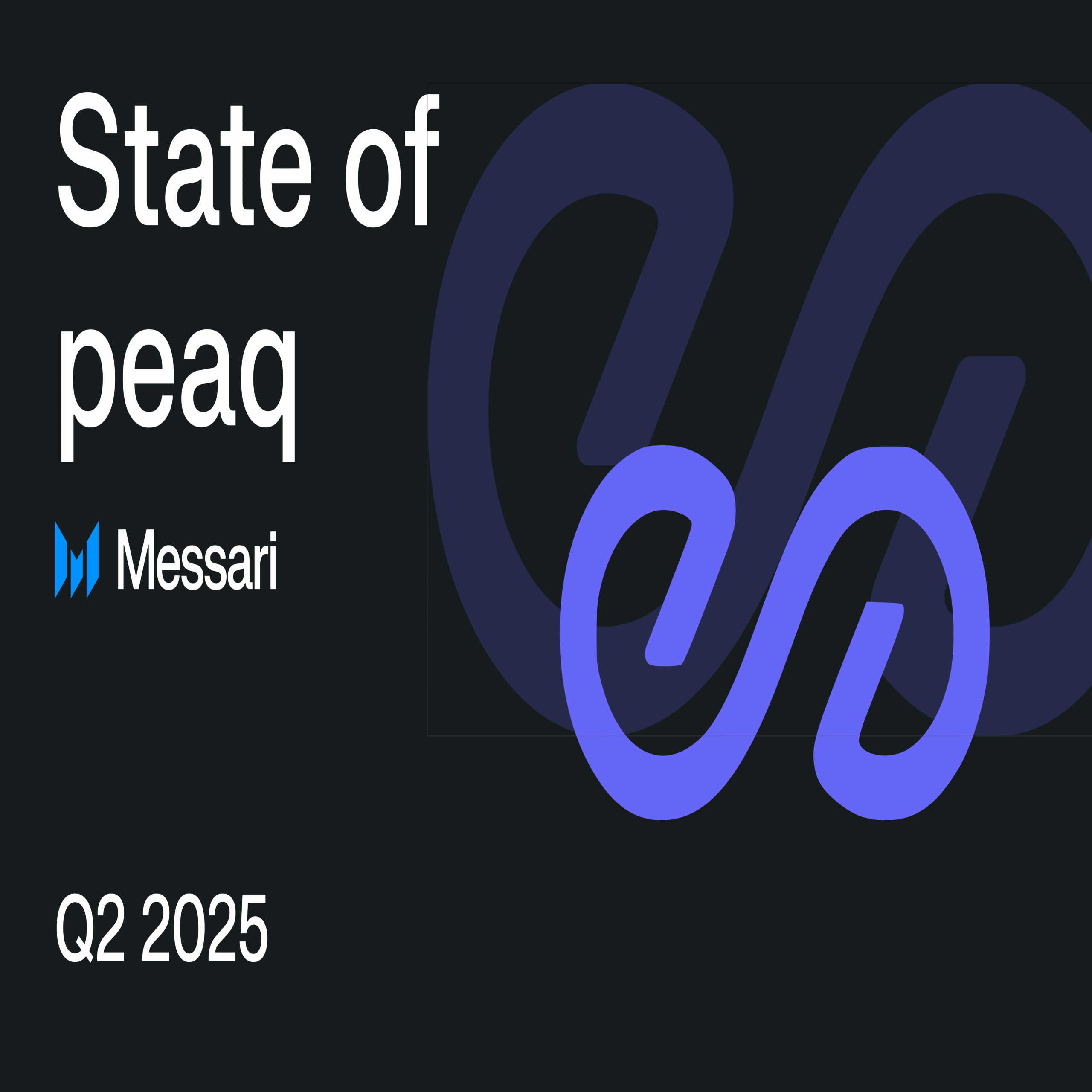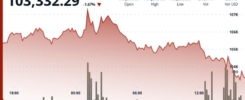Key Insights
- Average daily active addresses rose 10.5% QoQ, reaching 25,132 in Q2’25. This trend signals momentum in real activity as peaq shifts from initial adoption to ongoing engagement.
- Average daily transactions fell 33.6% QoQ, from 77,386 to 51,351. The decrease marks a correction after the initial surge of network activity following peaq’s mainnet launch, and corresponds with a temporary pause of the Get Real campaign.
- Protocol revenue totaled $21,550, down 51.4% QoQ. Lower transaction volumes and a drop in token price were the primary drivers of the revenue decline in Q2 2025.
- The Machine Economy Free Zone launched in the UAE. This established a dedicated sandbox and regulatory framework for DePIN, DePAI, and Machine DeFi projects.
- Q2 saw the launch of MachineX, the first DEX for the Machine Economy, alongside the expansion of major DePIN projects OVR, ThreeFold, and 375ai to peaq. Together, these developments showcase significant momentum for peaq’s Machine Economy.
Primer
Development on peaq began in 2017 by Till Wendler, Leonard Dorlöchter, and Max Thake, who shared a vision of integrating blockchain technology with the Internet of Things (IoT). Recognizing the limitations of existing infrastructure, they set out to create a Layer-1 (L1) blockchain tailored to support decentralized, machine-centric ecosystems. After years of collaboration with leading enterprises to explore blockchain’s impact on IoT applications, the team focused on building a platform for real-world use cases.
This effort culminated in peaq as an L1 to power Decentralized Physical Infrastructure Networks (DePINs), a concept central to the emerging Machine Economy. In March 2024, peaq announced it had raised $15 million in funding from leading investors, including Animoca Brands, Borderless Capital, Generative Ventures, Cypher Capital, CMCC, Fundamental Labs, HV Capital, Hashkey Capital, GSR Investments, MoonRock Capital, among others. In May 2024, peaq secured an additional $20 million in a CoinList launch.
Following peaq’s mainnet launch in mid-November 2024, Q2 2025 marked the second full quarter of network activity. The network supports DePIN, Decentralized Physical AI (DePAI), Machine DeFi, and tokenized Machine Real World Assets (RWAs), with 53 DePINs active by quarter’s end. peaq’s infrastructure enables machines to register identities, process micropayments, and interact autonomously with onchain applications.
Key Metrics
Financial Analysis
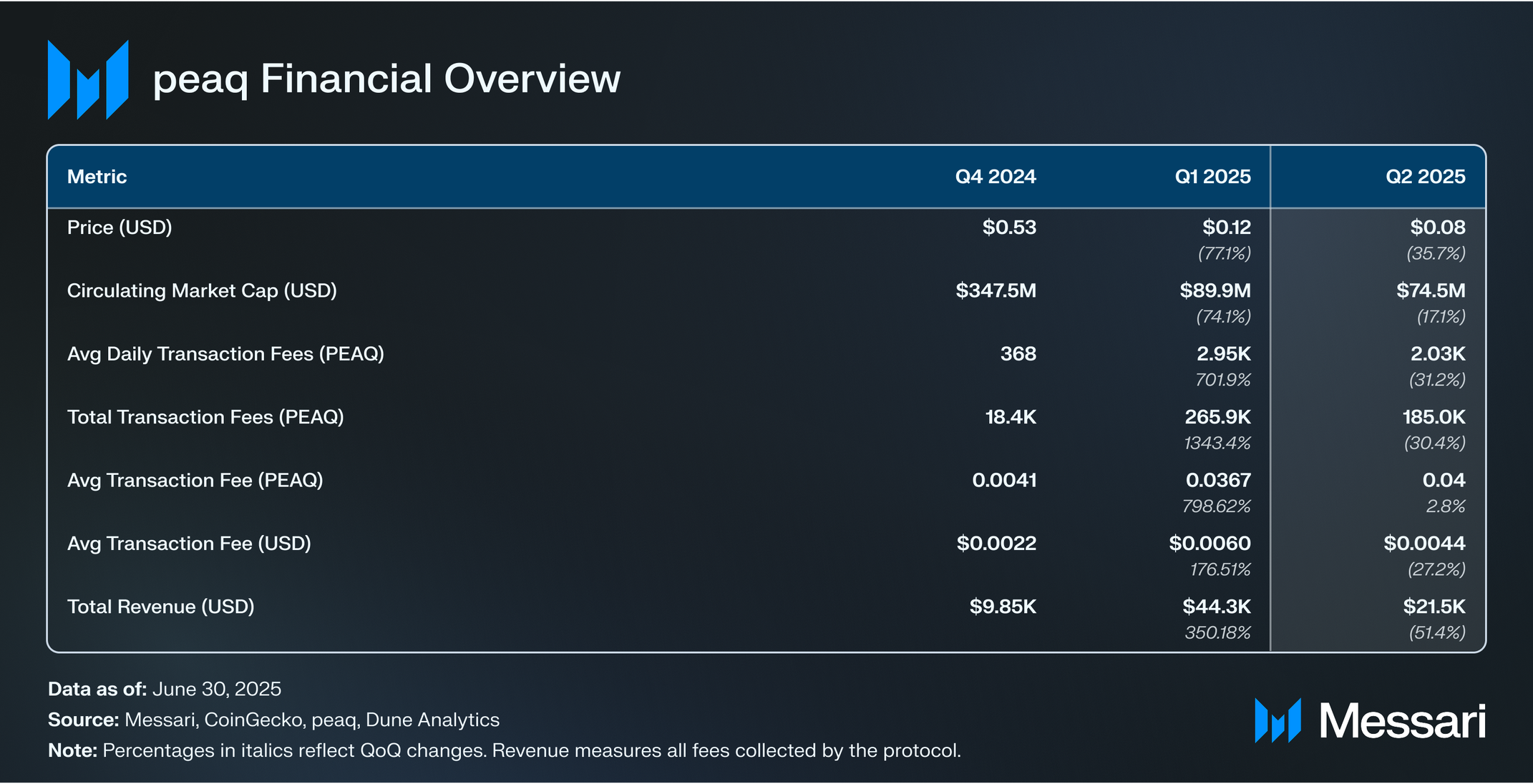
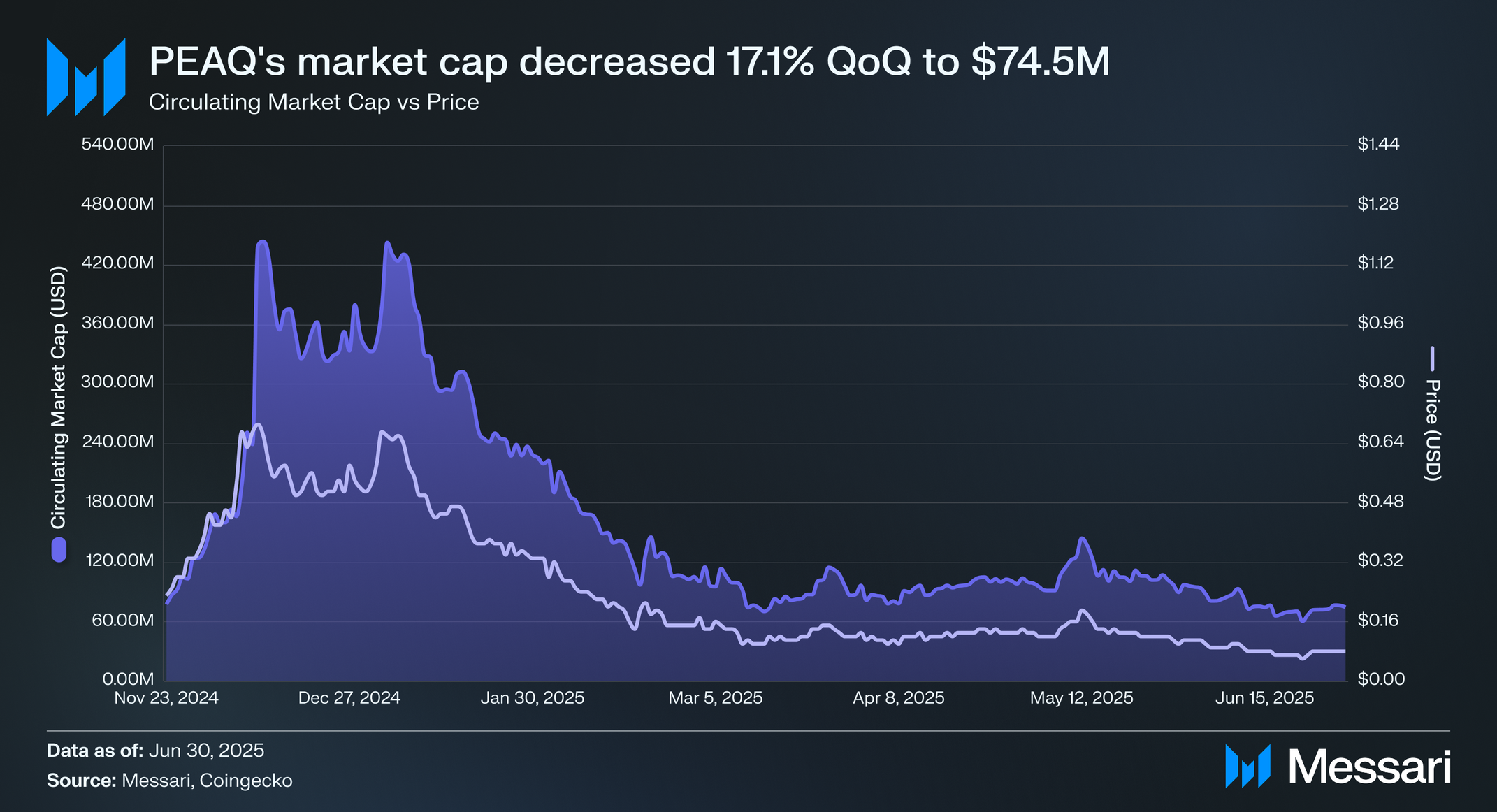
During Q2’25, peaq’s market cap decreased 17.1% from $89.9 million to $74.5 million while the circulating supply of PEAQ increased by 32.6% QoQ. The increase in circulating supply was due to community token allocations and the scheduled unlocks of investor allocations, alongside inflation. Additionally, PEAQ’s price fell 35.7% over the quarter from $0.12 to $0.08, ranking it 401st in market cap among all cryptocurrencies at the end of the quarter.
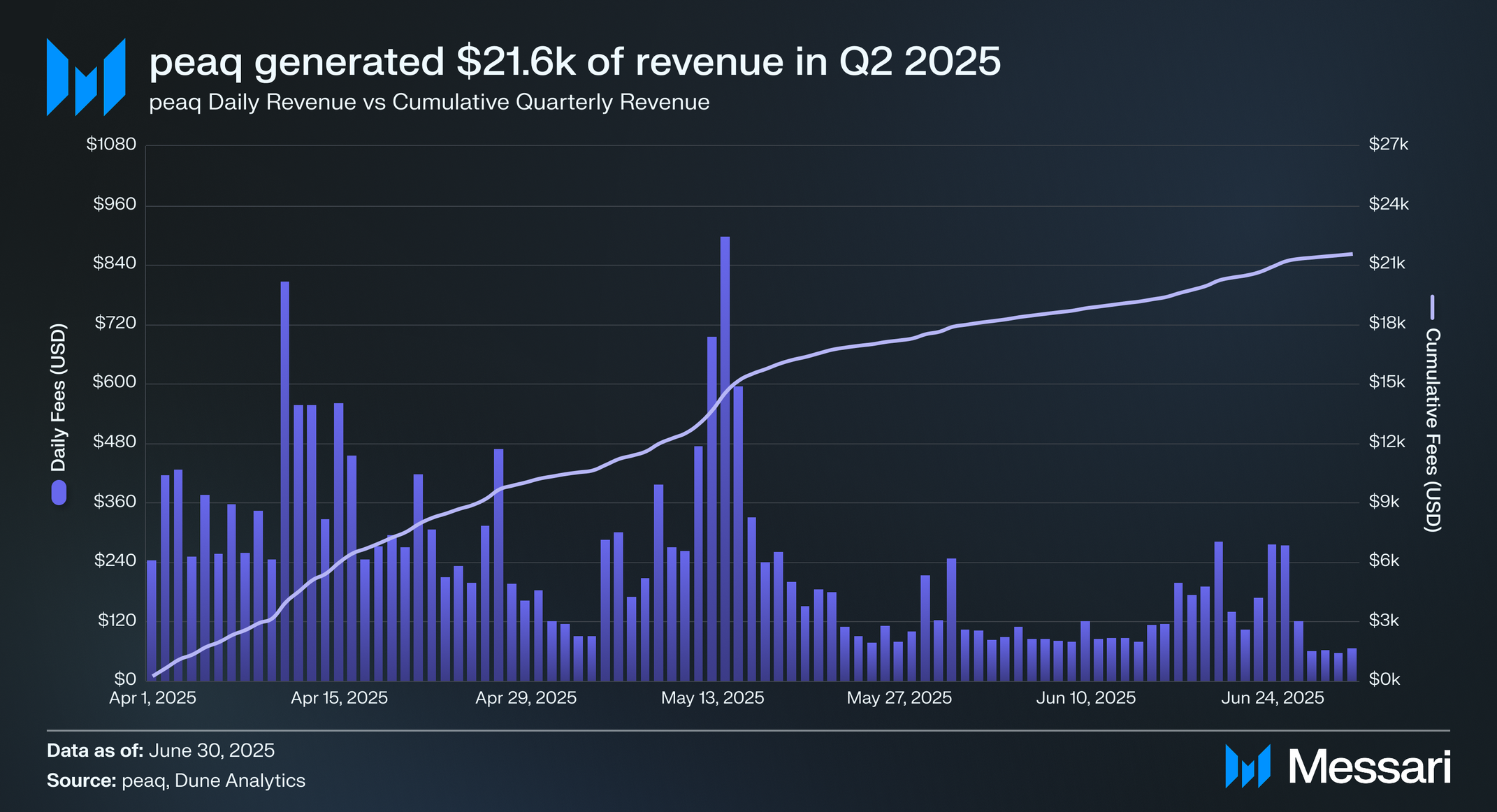
During Q2’25, peaq generated $21,550 in total revenue, i.e., all fees collected by the protocol. The network is designed for high-throughput and machine-to-machine interactions and employs a micro-fee model with transaction costs as low as $0.00025. These optimizations enable real-world applications to scale without prohibitive costs.
Revenue generation decreased steadily throughout Q2, falling 58.9% from an average of $337.06 per day in the first half of the quarter to $138.4 in the second. This decline was driven by lower transaction volumes and a slowdown in new human and machine address creation compared to Q1, following the pause of the Get Real Campaign after its first season.
peaq’s transaction fee model is designed to minimize user costs and support long-term sustainability through strategic revenue allocation. All transaction fees and a portion of newly minted tokens are distributed to network participants who actively engage in the ecosystem and meet specific contribution criteria, such as the value created by machines or liquidity provided to the network. This performance-based approach ensures fairness, drives community participation, and aligns stakeholder incentives. As of Q2’25, the distribution of transaction fees is as follows:
- Validators & Delegators – 40%
- Security Treasury – 10%
- General Treasury – 25%
- DePIN Treasury – 20%
- Machine Subsidization Treasury – 5%
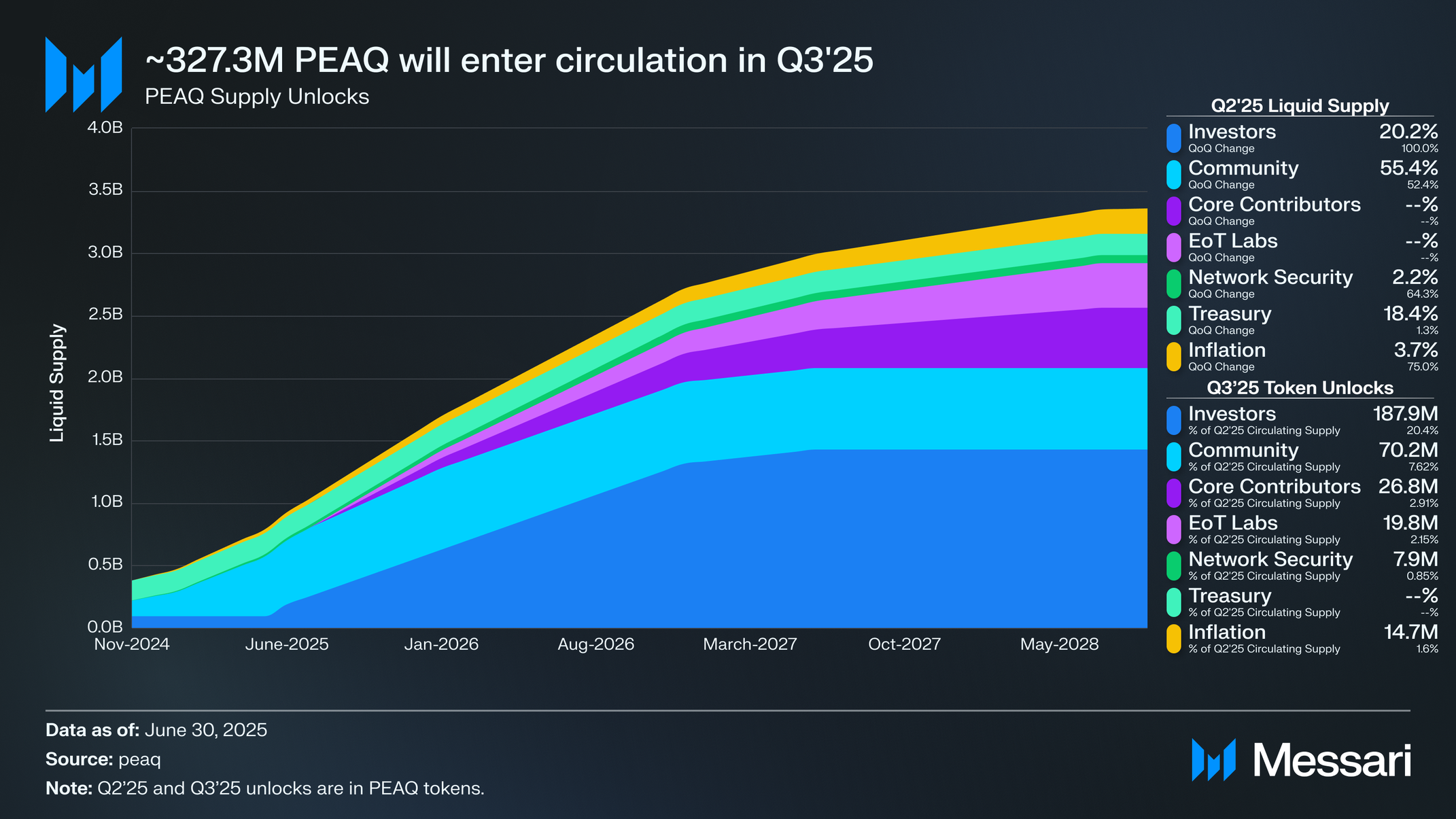
peaq launched in November 2024 with a total genesis token supply of 4.2 billion PEAQ and an initial annual inflation rate of 3.5%. The inflation rate is designed to decrease by 10% each year until it stabilizes at 1%, with future adjustments governed by the network. Of the newly minted tokens, 40% are allocated to staking rewards for delegators and validators, while the remaining 60% is directed to the treasuries described above and remains non-circulating. During Q2’25, 36.75 million PEAQ were minted through inflation. By the end of Q2’25, 21.9% of PEAQ’s genesis supply was liquid, marking a 68.5% QoQ increase. Looking ahead to Q3’25, an additional 312.6 million PEAQ, or 7.4% of PEAQ’s genesis supply, will unlock in addition to inflation.
The key components of the Q3’25 unlocks include:
- Investors (57.4% of Q3 unlocks): 187.9M PEAQ will unlock to private investors.
- Community (21.5% of Q3 unlocks): 70.2M PEAQ will unlock to the community.
- Core Contributors (8.2% of Q3 unlocks): 26.8M PEAQ will unlock to core contributors.
- EoT Labs (6.1% of Q3 unlocks): 19.8M PEAQ will unlock to the company building peaq.
- Network Security (2.4% of Q3 unlocks): 7.9M PEAQ tokens will be unlocked for network security.
- Inflation (4.5% of Q3 unlocks): 14.7M PEAQ are set to be minted from emissions, providing additional liquidity to the market and supporting ongoing network participation incentives.
Network Analysis
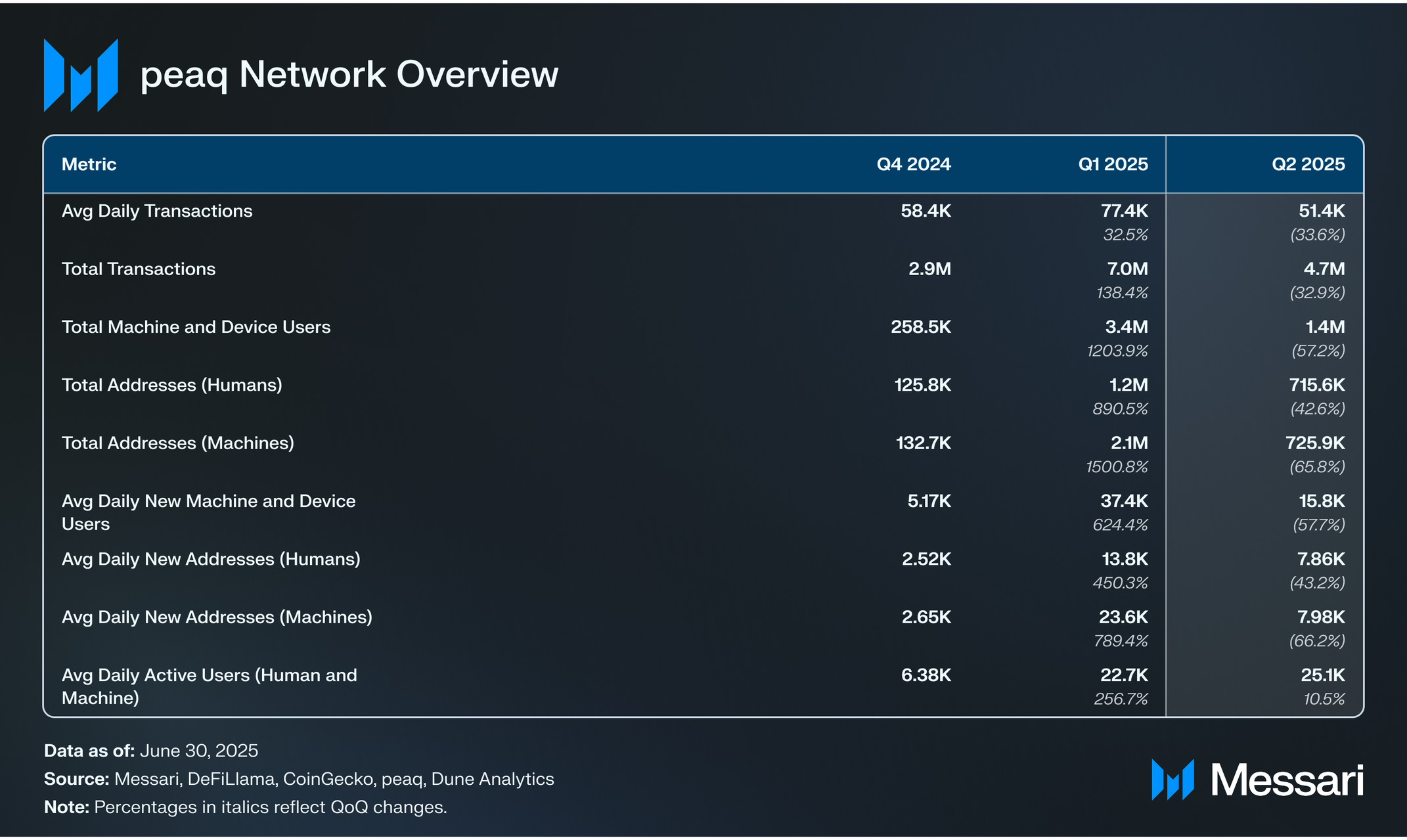
Usage
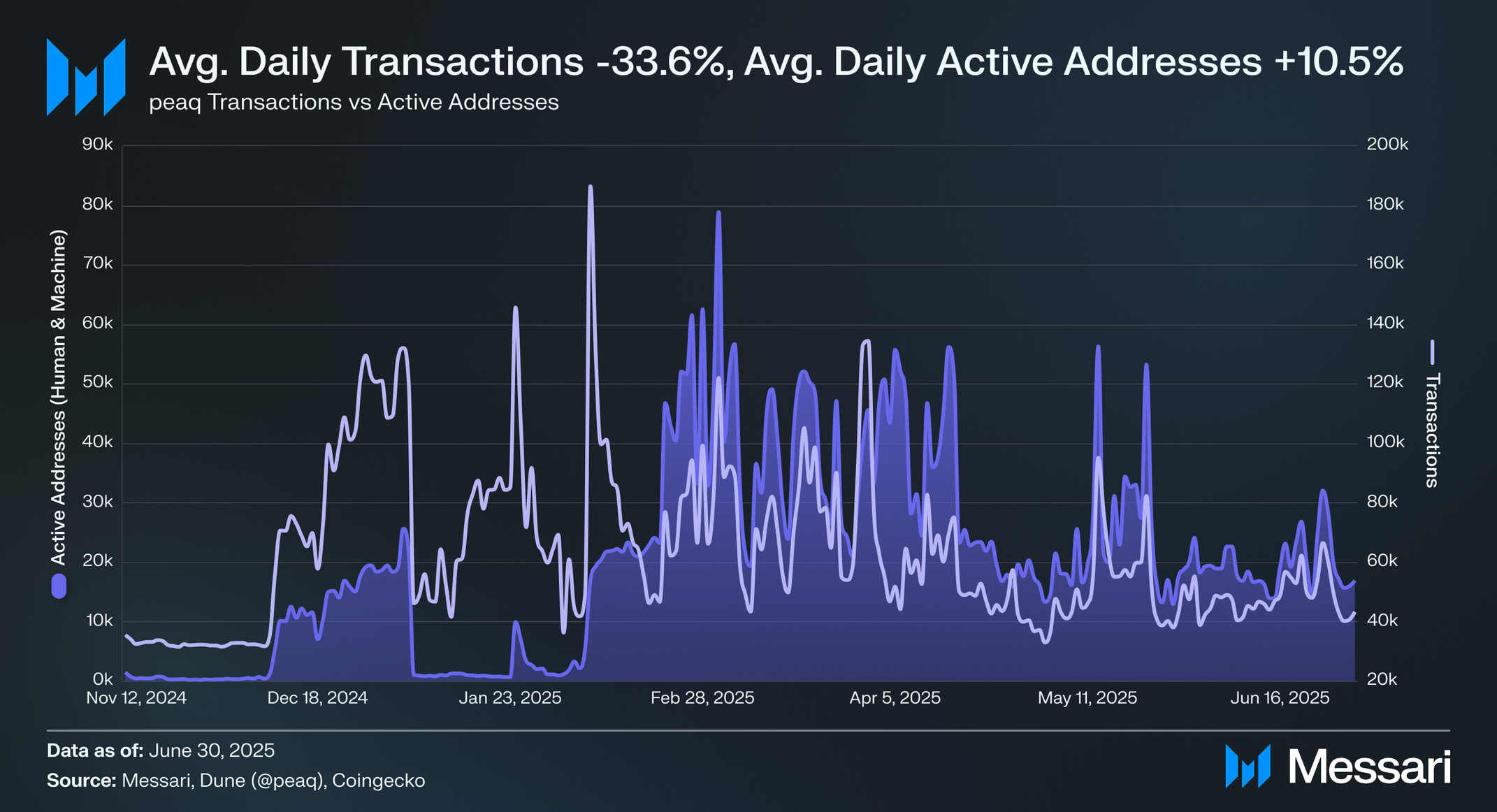
In Q2’25, peaq experienced a 10.5% QoQ increase in average daily active addresses (Human and Machine), which rose from 22,738 in Q1’25 to 25,132 in Q2’25. Average daily transactions on peaq fell 33.6% QoQ from 77,386 in Q1’25 to 51,351 in Q2’25.
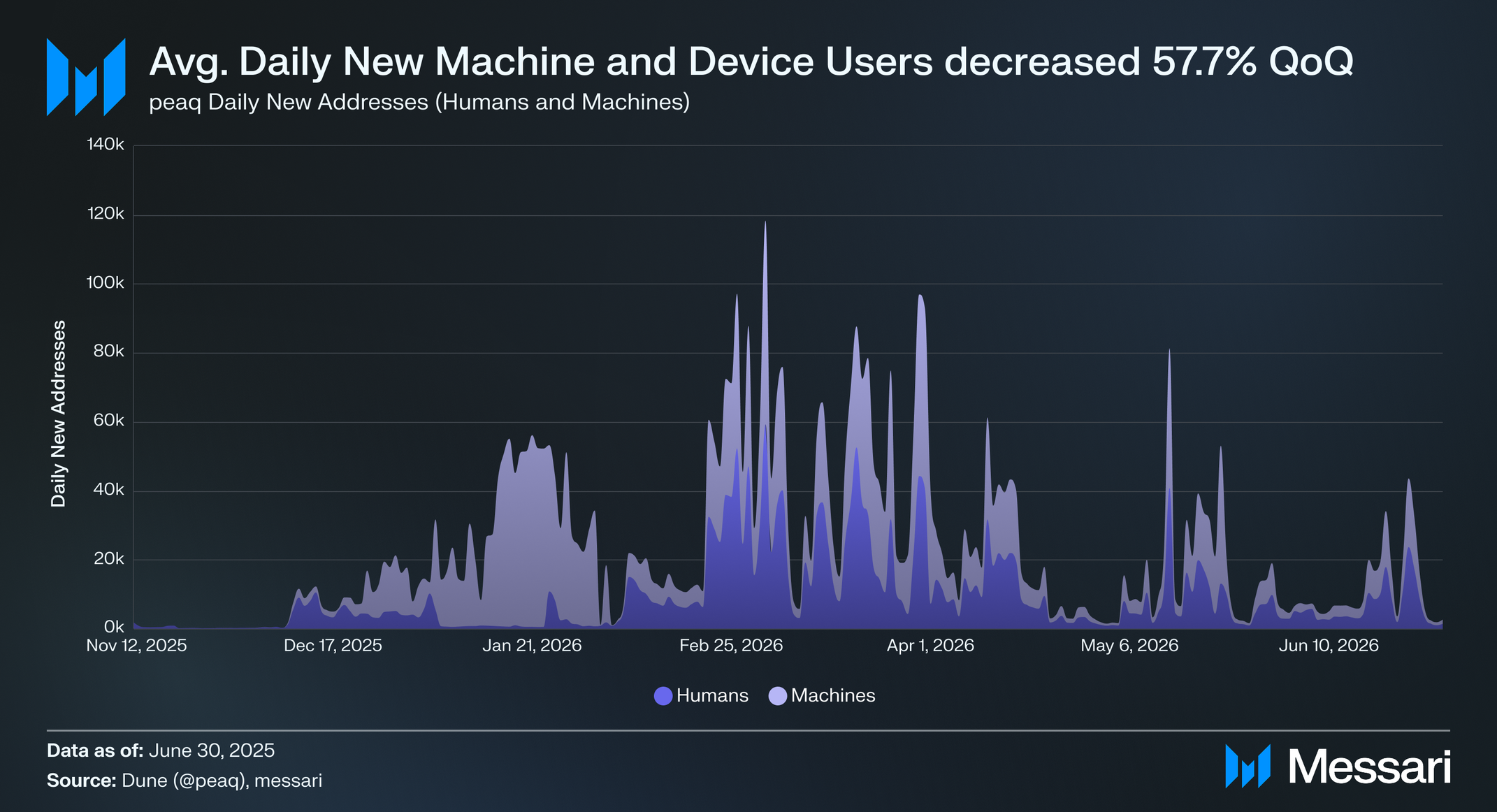
The creation of new addresses, human and machine-owned, on peaq fell in Q2’25. Average daily new human addresses fell 43.2% QoQ from 13,839 in Q1’25 to 7,863 in Q2’25, and average daily new machine addresses fell 66.2% QoQ from 23,603 in Q1’25 to 7,977 in Q2’25. Following a sharp growth in new users in Q1’25, Q2 saw a decline in growth rate as new address creation from both humans and machines slowed, corresponding with the pause of peaq’s Get Real campaign after its first season.
Despite the number of new addresses falling QoQ, Q2 2025 still recorded meaningful onchain expansion, with projects such as Silencio, Teneo, Dats, and MapMetrics deploying devices that required identity registration. This ongoing onboarding of machine-native use cases helped peaq’s total onchain addresses surpass 5 million by the end of Q2.
Ongoing community incentives also contributed to expansion. While the core Get Real Campaign is currently on pause, peaq teamed up with Kaito AI to create the Get Real Yapper Leaderboard, which drove awareness and engagement through Q2 by adding rewards for sharing content related to peaq on X.
Security
peaq uses a Nominated Proof-of-Stake (NPoS) consensus model built with Substrate, similar to Polkadot. In this system, validators are selected based on the stake they receive from self-bonding and delegators. This design helps optimize decentralization while aligning incentives between validators and token holders.
peaq follows a disinflationary token model in which the inflation rate starts at 3.5% annually and decreases by 10% yearly until stabilizing at 1%. Of the newly minted tokens, 40% enter circulation as staking rewards for validators and delegators, while the remaining 60% is directed to non-circulating treasury allocations aimed at long-term ecosystem development.
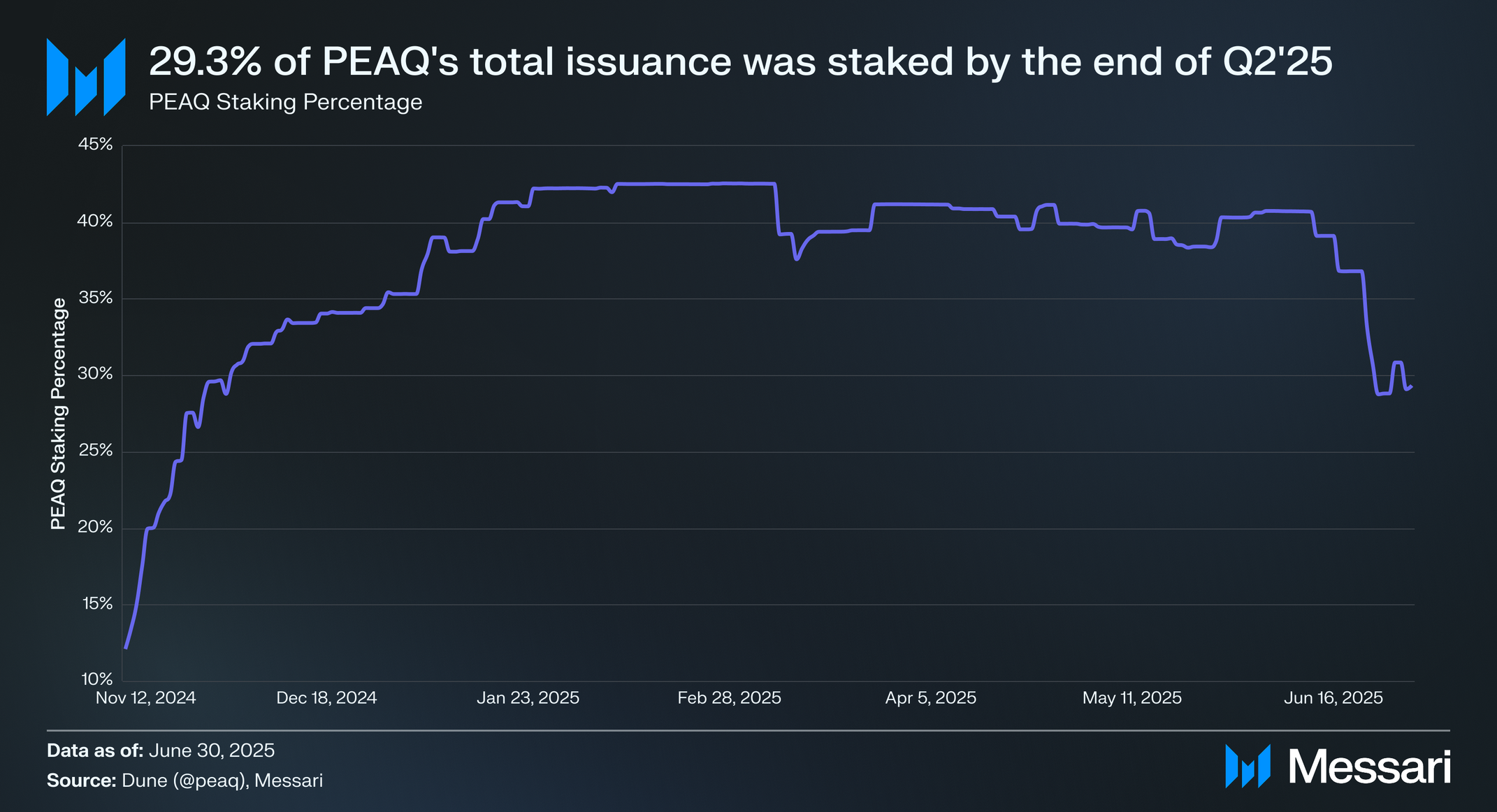
As of June 30, 2025, peaq is secured by 50 active nodes, 42 of which are selected as validators, and 1.26 billion staked PEAQ, which accounts for 29.3% of the total PEAQ issuance. The runtime upgrade in June 2025 raised the delegator cap to 100 per node, allowing more participants to join in securing the network. Validator participation is determined by stake-weighted selection, and rewards are distributed proportionally to both validators and delegators. In Q2’25, the active validator set remained capped at 42 validators.
Validator candidates must meet certain technical and economic requirements to join the active set, including maintaining uptime and infrastructure performance in line with network expectations. peaq uses a stake-weighted selection process, and validators are subject to removal for underperformance. The network is designed to include a slashing mechanism to penalize misbehavior such as downtime or malicious actions, reinforcing honest participation and ensuring protocol integrity. As of July 17, 2025, this feature has not yet been implemented.
Ecosystem Overview
peaq continued building out its Machine Economy network in Q2’25. This effort combines DePINs, DePAI (Decentralized Physical AI), Machine DeFi, and Machine RWAs. peaq also introduced a Machine Economy Free Zone (MEFZ) to accelerate development. These ideas form the foundation for applications where machines and people interact through onchain services tied to real-world value.
By the end of Q2’25, 53 DePINs had joined the peaqosystem. Six additional DePINs joined peaq during Q2’25:
- 375ai – an edge intelligence network.
- Aira – an air quality project with a wearable sensor that measures pollution.
- Alpha AI – a drone-powered project making high-resolution 3D maps.
- Axi – a community-powered e-mobility platform.
- Over The Reality – a geospatial 3D mapping platform.
- ThreeFold – a peer-to-peer internet infrastructure project.
peaq supports developer adoption through a suite of modular functions available through its SDK. These include machine ID, payment, access control, data verification, and time synchronization tools. With just ~15 lines of code, builders can integrate these into their applications, reducing complexity and accelerating deployment. The following ecosystem map provides a visual overview of the projects integrating peaq’s infrastructure and building on the network.
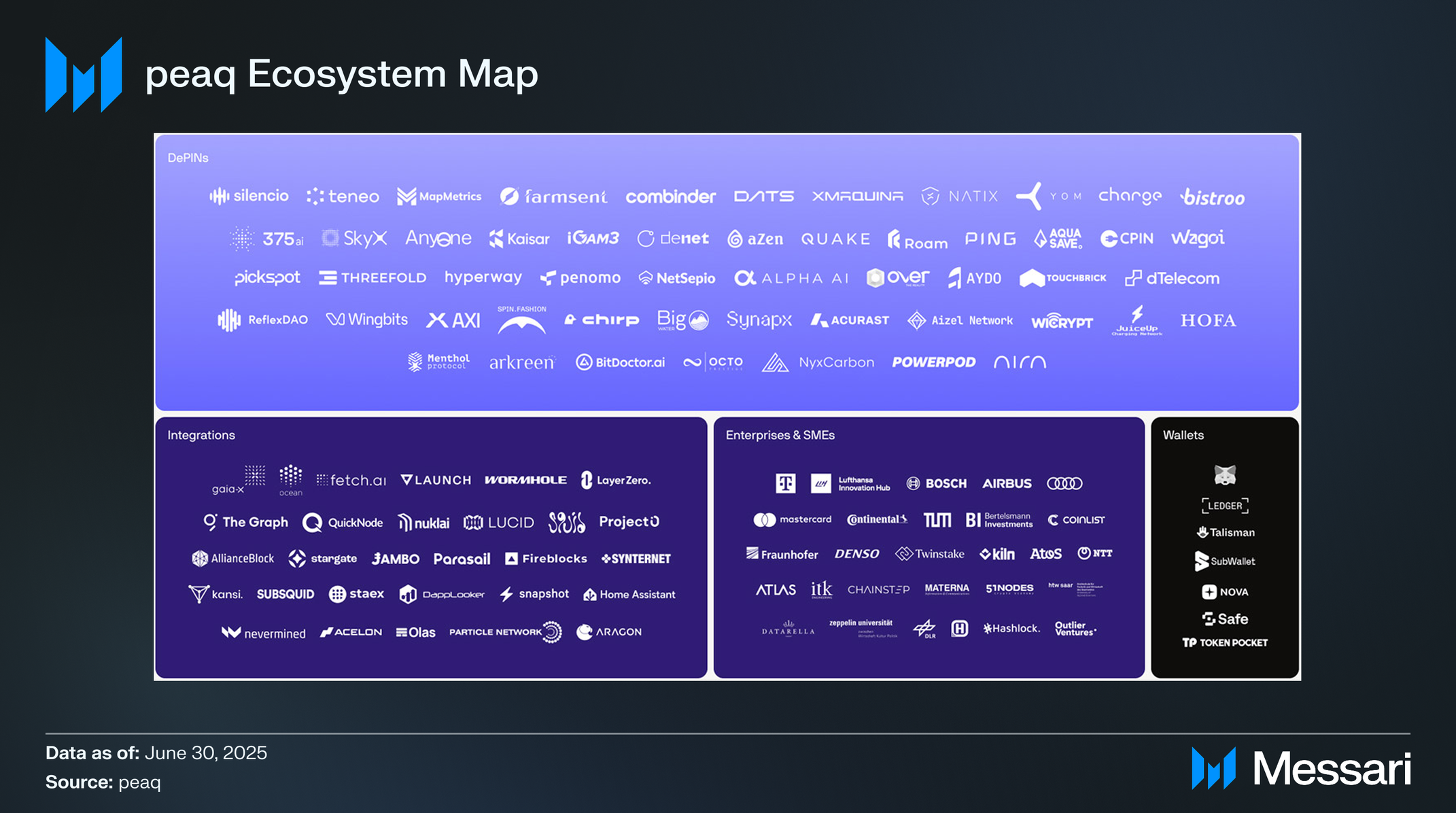
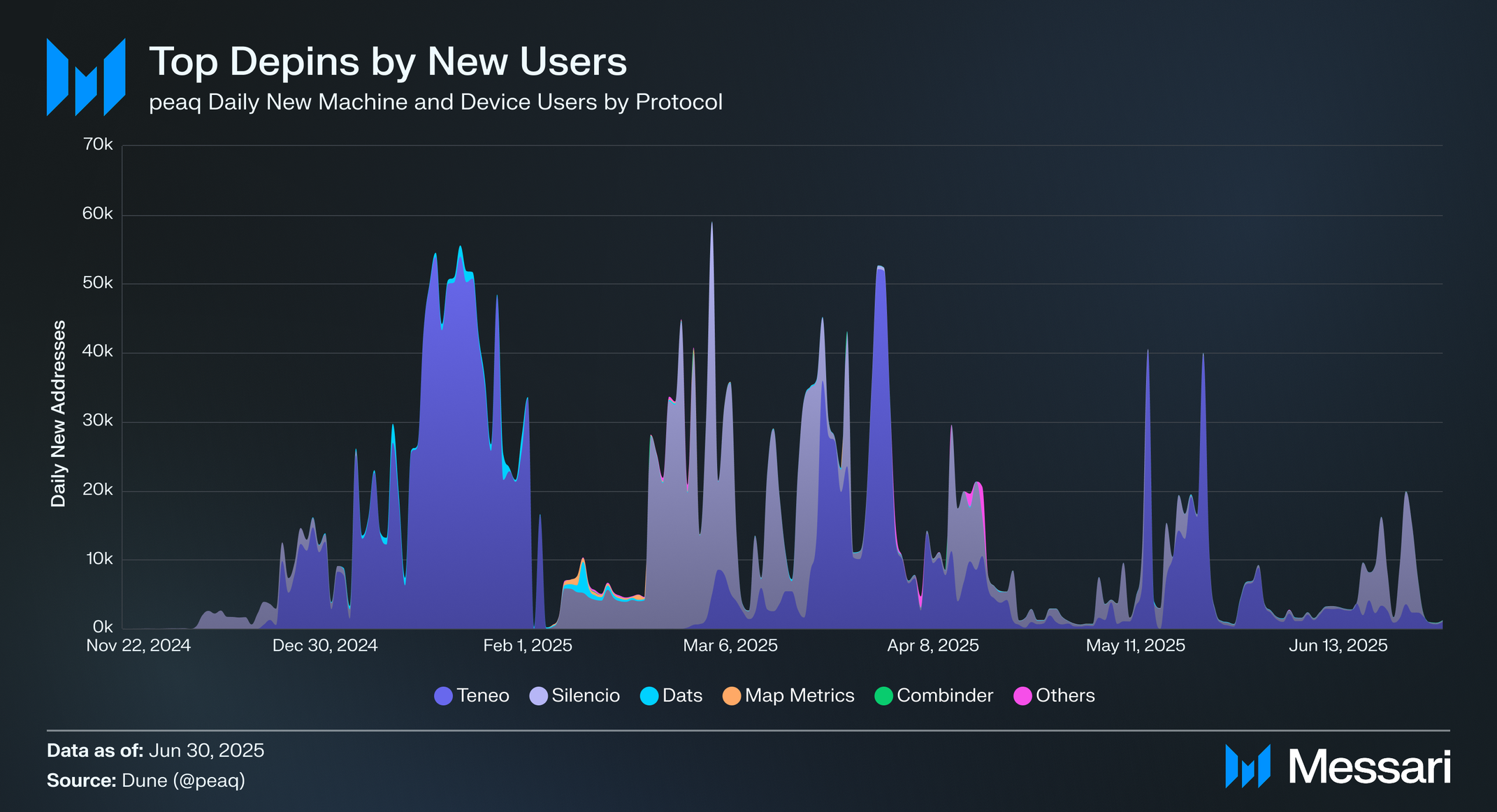
While network activity declined QoQ, peaq’s ecosystem expanded in Q2’25 through the continued onboarding of devices and machine identities. Teneo, a browser-based DePIN that rewards users for sharing public data on social media, added 476,313 new devices. Silencio, a mobile app that measures local noise pollution, contributed 233,581 new addresses. Additional contributions came from projects such as:
- DATS – a decentralized cybersecurity network.
- MapMetrics – a navigation DePIN, collecting real-time geospatial data.
- Combinder – a decentralized virtual power plant onboarding distributed energy resources.
Towards the end of Q2, peaq announced that its token would be listed on Kraken, a large Tier-1 exchange that would expand access and increase the network’s visibility. The listing took place shortly after the announcement. Also in Q2, iG3 announced a migration from Arbitrum to peaq, signaling confidence in the network’s ability to support DePIN activity.
The ecosystem saw increased capital and marketing efforts in Q2: five rounds of PEAQ Vested Emission Offerings (VEOs) were sold out through Lucid Labs, raising $306K in vested token sales; The DePIN Base Camp II accelerator awarded $1 million in seed grants from 1kx across five teams; and peaq teamed up with Kaito to launch the Get Real Yapper Leaderboard, which was made to reward those who effectively spread awareness of the Machine Economy.
Machine Economy Free Zone
In Q2, peaq and the UAE’s Pulsar Group announced the world’s first Machine Economy Free Zone (MEFZ). The MEFZ is a regulatory sandbox to accelerate deployment, funding, and innovation of machine-powered infrastructure. Initial initiatives focus on: a framework for Machine Tokenization, which would let anyone invest in machines; and Universal Basic Ownership, which allows communities to receive portions of machine-generated income. To help support the MEFZ, peaq is setting up its official headquarters in the UAE.
In collaboration with Pulsar, peaq also hosted the Machine Economy Days, an event series across Abu Dhabi and Dubai, highlighting the growth of DePINs on peaq. Notably, several high-ranking UAE government officials attended the event. This marks peaq as well as the UAE as the hub for DePIN and the Machine Economy.
Machine DeFi and RWAs
peaq’s financial architecture continued to mature towards the goal of machines as direct participants in economic systems. In Q2, peaq advanced from initial groundwork by introducing the Machine DeFi Stack to bring the foundational layer of DeFi primitives online.
Machine DeFi refers to the emerging category of decentralized finance in which machines could eventually transact autonomously with protocols, using onchain data derived from their activity. Envisioned use cases include borrowing against tokenized machine revenue, automated fee flows between machine agents, and DAO-managed subsidy programs. While these remain aspirational today, peaq’s infrastructure upgrades and modular functions are designed to support such interactions as they mature.
A foundational component of this vision is Machine RWAs. These are machines, or rights to their services and output, represented as onchain assets. This model enables token holders to earn from machine performance and allows devices to interact with DeFi protocols using verifiable, real-world metrics. Although no Machine RWAs are actively deployed on peaq as of this report, the groundwork for tokenization, identity, and payment processing is now in place.
A key enabler of these future applications arrived in Q2’25 with the launch of MachineX on peaq. MachineX is the world’s first DEX built for the Machine Economy, providing a liquidity marketplace for DePIN tokens, PEAQ, and, soon enough, Machine RWAs. By having such a marketplace, machines and users gain access to dedicated liquidity pools for assets, which is critical for financial coordination and capital allocation.
MachineX routes a portion of every swap’s fees into peaq’s Network-Level Incentive Pools. Funds in those pools incentivize the growth of DePIN’s building on peaq and subsidize the onboarding of machine RWAs. As liquidity and swap volume grow, more fees are directed into the incentive pools, and DePIN projects are encouraged to make more impactful developments. By doing this, MachineX generates a liquidity flywheel for the growth of the Machine Economy.
peaq expanded the Machine DeFi ecosystem with Anyone Protocol’s ANYONE and Silencio’s SLC tokens being listed on MachineX. peaq also introduced liquid staking through Parasail Finance, which offers more flexibility for token holders who want to stake without locking liquidity.
Looking ahead, the rollout of Machine DeFi suite V2 is a major focus of peaq’s roadmap in Q3 2025. The planned introduction of Machine RWAs, a native stablecoin, machine-native money markets, a native DePIN launchpad, and more integrations of bridges, aggregators, wallets, etc., are intended to transform peaq’s early milestones in Q2 into a fully operational financial layer for the Machine Economy.
Decentralized Physical AI (DePAI)
While Machine DeFi and Machine RWAs introduce financial tools and ownership models for machines, the next step is equipping those machines with the intelligence to operate independently. As autonomous systems take on more responsibility across sectors, their ability to interact, make decisions, and transact onchain becomes essential. This shift is taking shape with the emergence of decentralized physical AI (DePAI), a model that integrates robotics, agentic AI, and Web3 infrastructure into a new layer of the Machine Economy. In Q2 2025, multiple projects on peaq demonstrated progress in enabling machines to function autonomously and create value onchain.
DePAI is composed of seven foundational layers:
- Hardware – robots that allow AI models to interact with the physical world.
- Software – agentic AI models running on those robots.
- Data – allows the physical AI to learn and evolve.
- Spatial Intelligence – Enables robots to comprehend and interact with the physical world.
- Infrastructure Networks – provide the key requirements like storage, compute, energy, and more.
- A Machine Economy – This layer brings together all dedicated protocols that ensure interoperability and precise coordination between DePINs, AI models, and robots.
- DAOs – Allow individuals, communities, and businesses to own and earn from the DePAIs.
Projects such as Silencio, SkyX, and Teneo contribute critical sensor data to the network. In Q2, Veraset, a major mobility and location intelligence provider, integrated Silencio’s noise-level dataset. SkyX’s weather feeds were integrated by QuakeCore to detect early signs of hurricanes and tsunamis, showing how DePIN data can inform urgent decision-making. New projects such as AlphaAI and OVR joined the peaq ecosystem this quarter to strengthen the spatial intelligence layer, using drone swarms and geospatial networks to build maps that help machines navigate environments independently.
Meanwhile, peaq joined Intercognitive, with its first contribution being Universal Machine Time (UMT) to provide coordination to the Machine Economy layer. In terms of DAOs and governance, growth in this layer is supported by the XMAQUINA DAO, a decentralized organization focused on funding and overseeing the development of robotics and Physical AI. In Q2 2025, XMAQUINA expanded its community and treasury via a second public DEUS token auction, raising more than $1.45M. This model allows communities to co-own, co-govern, and benefit from DePAI applications built on peaq.
These components form the foundation for machines to operate autonomously, generate value, and coordinate with other agents onchain. While DePAI is still in its early stages, peaq has been assembling the infrastructure needed to support it, from machine identity and time synchronization to data feeds and decentralized governance. DePAI is positioned to become a core layer of the Machine Economy as these systems evolve, enabling intelligent machines to interact directly with decentralized applications and financial protocols.
DePINs on peaq
In Q2’25, peaq continued to attract new DePINs that expanded the scope and diversity of its ecosystem. These projects use peaq’s infrastructure to onboard devices, structure incentives, and link machine activity to onchain value. From geospatial mapping and clean air to sustainable mobility and internet infrastructure, this quarter’s additions illustrate how peaq is becoming a foundation for real-world applications across multiple sectors.
375ai
375ai joined the peaq ecosystem in Q2 as a DePIN project focused on building an edge data intelligence network. The project enables users to earn rewards by passively collecting and verifying real-world data such as traffic conditions, air quality, and weather. This is done through the 375go mobile app, which focuses on measuring local mobile coverage quality, or edge nodes, called 375edge. They aim to put data ownership and monetization in the hands of users rather than big corporations.
375ai has partnered with fellow DePIN project AYDO to expand its edge network via the 375x initiative, and Outfront Media, which allows node placement at any of its billboards. Originally based on Solana, 375ai is expanding its reach with peaq. The project will leverage peaq’s modular DePIN functions and add an option for users to receive rewards on peaq.
Aira Labs
Aira Labs is part of the DePIN Base Camp accelerator and joined the peaq ecosystem in Q2 as a DePIN project focused on clean air. The project is developing a wearable sensor and mobile app that tracks air quality in real time. Aira aims to build the world’s most extensive air pollution map by crowdsourcing measurements of pollutants such as dust or smoke particles. Users can get personalized health insights and earn token rewards for contributing their local air-quality readings to a global database.
Aira Labs will use peaq IDs to authenticate each sensor and plans to launch its token on peaq, integrating into peaq’s network of DePIN applications. This integration positions Aira to scale its decentralized air-quality network while promoting transparent, user-owned data governance.
Alpha AI
Alpha AI joined the peaq ecosystem in Q2 as a DePIN project focused on building high-detail maps of urban areas. The project deploys drones to capture high-resolution images and generate 3D maps of cities, to allow autonomous drone navigation within cities. Initial deployments are concentrated in Hong Kong. Users earn rewards for contributing and validating map data, with submissions recorded on peaq.
Alpha AI will use peaq IDs for their drones and stations, so each device has a unique machine identity. The project will implement its token rewards on peaq and integrate with other peaq DePIN functions. The project also works with other DePINs in peaq’s ecosystem: Auki Labs and GEODNET.
AXI Mobility
Axi Mobility joined the peaq ecosystem in Q2 as a DePIN project focused on sustainable transportation. The project combines ride-hailing, public transportation, delivery services, and charging services into one platform.
AXI Mobility will use peaq IDs for all its electric devices, including vehicles, scooters, bikes, and charging stations. As part of the peaq integration, AXI Mobility will launch its token AXI on peaq and utilize peaq’s infrastructure for reward distribution.
Over the Reality
Over the Reality joined the peaq ecosystem in Q2 as an established DePIN project focused on geospatial mapping. The project leverages users to build an advanced map via its map2earn program, where users earn rewards to capture their surroundings with a smartphone.
Over the Reality, which already has an established token, will be minting some supply of its OVR token on peaq as part of its partnership. The OVR token is already listed on MachineX. The project will issue peaq IDs for devices in its network to securely tie contributions to device identities, as well as implement its token reward system on peaq.
Threefold
ThreeFold joined the peaq ecosystem in Q2 as a DePIN project focused on internet infrastructure. The project rewards users for deploying nodes and joining their infrastructure layer, ThreeFold Grid, through contributing storage, computing, and network capacity.
ThreeFold will utilize peaq’s DePIN modules and assign peaq IDs to its devices for secure authentication and accurate logging of network contributions.
Integrations
In Q2’25, peaq integrated several protocols into its infrastructure, solidifying pieces to facilitate the machine economy. These integrations make it easier to interact with peaq’s ecosystem.
Squid Router
peaq added multichain support through an integration with Squid, a cross-chain liquidity router. The integration allows direct transfers from Squid’s integrated networks to peaq, streamlining onboarding and reducing friction with cross-chain interactions. Simplifying asset bridging and improving access to liquidity enhances the network’s usability.
Acelon
peaq introduced an integration with Acelon, a crypto price oracle. By incorporating an oracle into the ecosystem, protocols can reliably reference updated market data for smart contract use cases.
Project Zero
peaq brought real-time blockchain data to AI agents and dApps through their integration with Project Zero. This will help enable smarter automation and give apps in the Machine Economy faster reaction times to fluctuating market conditions.
The Graph
peaq integrated with The Graph for easier access to data. Giving developers the ability to query indexed blockchain data without running their own data node lowers infrastructure overhead and speeds up the development of dashboards, analytics, and dApps on peaq.
OKX Wallet
peaq added support for OKX Wallet. Now, users can securely store, send, and receive PEAQ tokens directly through the wallet interface. This simplifies token management for users and broadens peaq’s accessibility.
Roadmap
peaq’s roadmap for Q3 2025 focuses on scaling the network’s infrastructure, expanding Machine DeFi, and deepening developer and user engagement. These milestones are designed to transition the Machine Economy from early activation into broader adoption and technical maturity.
Q3 2025
- Machine DeFi Suite V2
- Introduction of Machine RWAs
- Launch of the peaq-native Stablecoin
- Development of Machine-native money markets
- Launch of the peaq-native DePIN Launchpad
- More integrations with bridges, aggregators, wallets, and other infrastructure
- Build
- Achieve 65,000 TPS and <0.4s block times on mainnet
- Chain fee market upgrade
- Major developer experience improvements
- peaq portal V2
Closing Summary
Q2’25 marked the second full quarter of activity following peaq’s mainnet launch, with critical infrastructure and ecosystem milestones being delivered. MachineX, the first DEX for the Machine Economy, went live. The Machine Economy Free Zone in the UAE was announced and went live with the Machine Economy Days events. Meanwhile, cross-chain and developer integrations with Squid, Acelon, The Graph, Project Zero, and OKX Wallet further lowered barriers for users and builders. Despite market headwinds, Q2 was a period of strong expansion for peaq, as it solidified its position as a leading platform for DePINs.
With 53 DePINs now building on peaq and Q3’s roadmap set for Machine DeFi Suite V2, Machine RWAs, and the peaq-native DePIN Launchpad, peaq enters the next quarter well-positioned to support autonomous machines, economic coordination, and community-owned physical infrastructure at scale.
Let us know what you loved about the report, what may be missing, or share any other feedback by filling out this short form. All responses are subject to our Privacy Policy and Terms of Service.
This report was commissioned by peaq Network. All content was produced independently by the author(s) and does not necessarily reflect the opinions of Messari, Inc. or the organization that requested the report. The commissioning organization may have input on the content of the report, but Messari maintains editorial control over the final report to retain data accuracy and objectivity. Author(s) may hold cryptocurrencies named in this report. This report is meant for informational purposes only. It is not meant to serve as investment advice. You should conduct your own research and consult an independent financial, tax, or legal advisor before making any investment decisions. Past performance of any asset is not indicative of future results. Please see our Terms of Service for more information.
No part of this report may be (a) copied, photocopied, duplicated in any form by any means or (b) redistributed without the prior written consent of Messari®.
